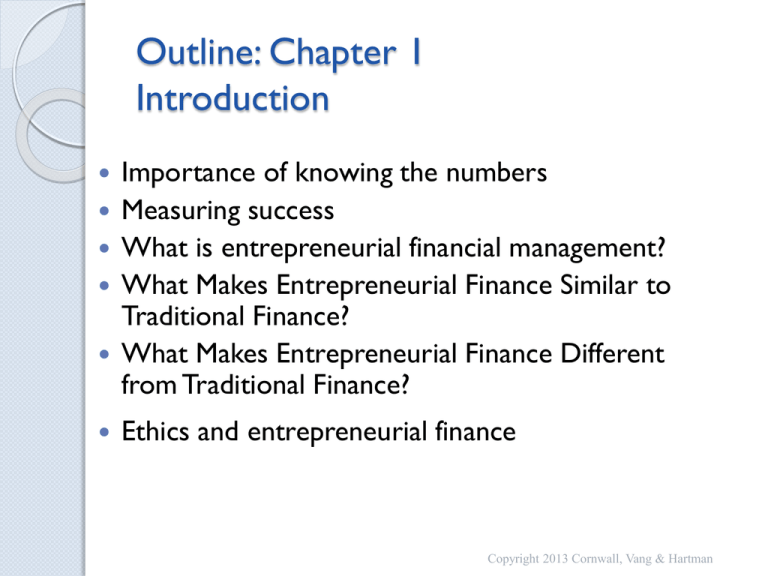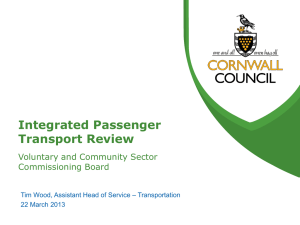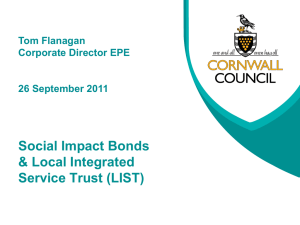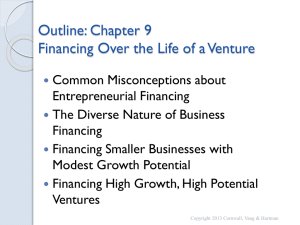Chapters 1-6 - Dr Jeff Cornwall
advertisement

Outline: Chapter 1 Introduction Importance of knowing the numbers Measuring success What is entrepreneurial financial management? What Makes Entrepreneurial Finance Similar to Traditional Finance? What Makes Entrepreneurial Finance Different from Traditional Finance? Ethics and entrepreneurial finance Copyright 2013 Cornwall, Vang & Hartman Financial Management: The “Language” of Business Used to set clear financial goals Used to make decisions Used to forecast Used to manage cash flow Used to seek financing Used to determine an exit process for the business Copyright 2013 Cornwall, Vang & Hartman Measuring “Success” Income for entrepreneur Wealth for entrepreneur Goals derived from personal values of the entrepreneur Copyright 2013 Cornwall, Vang & Hartman Differences between Traditional and Entrepreneurial Finance Lack of historical data to measure risk Lack of historical data and liquidity complicate the practice of finance in early stage firms Copyright 2013 Cornwall, Vang & Hartman Perspective of Investors Prefer less risk Diversified investors concerned with systematic risk Non-diversified investors concerned with total risk Prefer more return Prefer quick return Prefer liquidity Investors face many different opportunities No investors are immune from these expectations Copyright 2013 Cornwall, Vang & Hartman Finance Relationships Total Risk = Diversifiable Risk + Nondiversifiable Risk Required Rate of Return = Rf + Beta(Rm - Rf) Rf = Risk-Free Rate of Return Rm = Return on Market Index like SP500 Rm-Rf =Market Risk Premium Beta is a measure of Nondiversifiable Risk Beta < 1 means asset is less volatile than market (safe asset) Beta = 1 means asset is just as volatile as market (average asset) Beta > 1 means asset is more volatile than market (risky asset) Copyright 2013 Cornwall, Vang & Hartman Figure 1.1 Building a Financial Forecast Setting Financial Goals Revenue Forecasting Expense Forecasting Monitoring Performance Copyright 2013 Cornwall, Vang & Hartman Table 1.1 Example of Stakeholder Analysis Stakeholder Family Ethical Principle Application Create balance between work demands and family time. Establish a more moderate financial growth goal to allow for time with family. Investors Deal with all investors openly and honestly. Develop a financial reporting system that provides full and accurate historical information as well as realistic forecasts. Employees Share financial success with those that helped create it. Profit sharing, stock option plans, phantom stock, ESOP, etc. while still meeting goals of entrepreneur. Table 1.1 Example of Stakeholder Analysis (continued) Stakeholder Ethical Principle Application Fair pricing Establish revenue forecasts that are Customers realistic given this pricing principle. Suppliers Prompt payment for money owed. Establish cash forecasts that are based on an assumption of prompt payment of all invoices submitted by suppliers/vendors. Banker Honest disclosure of information Assure timely and accurate financial reporting and reasonable financial forecasting. Community Reliable employment for Manage cash flow to allow for the community. stable employment even during times of temporary slowdowns Outline: Chapter 2 Setting Financial Goals Wealth vs. income Integrating non-financial goals Importance of self-assessment The self-assessment process The model and business plan Copyright 2013 Cornwall, Vang & Hartman Figure 2.1 Model for Entrepreneurial Financial Management Setting Financial Goals Revenue Forecasting Expense Forecasting Monitoring Performance Copyright 2013 Cornwall, Vang & Hartman Life Cycle of a Business Venture Figure 2.2 Maturity Pre-Launch Start-up Growth Copyright 2013 Cornwall, Vang & Hartman “Quick and Dirty” Valuation EBITDA + extra bonuses or compensation to owners = adjusted EBITDA X earnings multiple = Valuation - Outstanding Loans = Cash proceeds to owner Copyright 2013 Cornwall, Vang & Hartman Integrating Non-Financial Goals Ethics and values Personal definition of “success” in business Family Community Personal interests Copyright 2013 Cornwall, Vang & Hartman Business Plan Outline Executive Summary The Business Concept Value Proposition and Industry Analysis Marketing Plan Operating Plan Financial Plan Copyright 2013 Cornwall, Vang & Hartman Importance of Self-Assessment Keeps your goals front and center Financial goals change Non-financial goals change Part of on-going exit planning Copyright 2013 Cornwall, Vang & Hartman Outline: Chapter 3 Understanding Financial Statements Accounting equation Assets = Liabilities + Owners’ Equity Basic financial statements Limitations of business financial statements Copyright 2013 Cornwall, Vang & Hartman Basic Financial Statements Income Statement Balance Sheet Statement of Cash Flows Copyright 2013 Cornwall, Vang & Hartman Income Statement Exhibit 3.1 The Company Month ended April 30, 2012 Sales $35,000 100.0% Cost of Goods Sold 10,000 28.6% Gross Profit 25,000 71.4% 10,000 28.6% Utilities Expense 2,000 5.7% Wages Expense 5,000 14.3% Depreciation Expense 1,000 2.8% Total Operating Expenses 18,000 51.4% Earnings before interest and taxes (EBIT) 7,000 20.0% Operating Expenses Rent Expense Interest Expense Earnings before taxes 100 .3% $ 6,900 19.7% Copyright 2013 Cornwall, Vang & Hartman Balance Sheet Exhibit 3.2 The Company April 30, 2012 ASSETS Current Assets Cash Accounts Receivable Inventory Total Current Assets Fixed Assets Equipment Less: Accumulated Depreciation Net Fixed Assets TOTAL ASSETS LIABILITIES Current Liabilities Notes Payable Accounts Payable Wages Payable Total Current Liabilities STOCKHOLDERS’ EQUITY Common Stock Retained Earnings Total Stockholders’ Equity TOTAL LIAB. & STOCKHOLDERS’ EQUITY $ 58,900 25,000 30,000 113,900 36,000 (1,000) 35,000 $148,900 $ 15,000 22,000 5,000 42,000 100,000 6,900 106,900 $148,900 Copyright 2013 Cornwall, Vang & Hartman Limitations of Financial Statements Not all assets of a company are included (e.g. employees or brand names) Intellectual property not reflected as an asset Assets are reflected at historical cost Estimates must be used for depreciation, the collectibility of accounts receivable, the salability of inventory, and the amount of warranty liability outstanding Financial statements affected by the choice of accounting methods (e.g. FIFO, LIFO or average cost) Copyright 2013 Cornwall, Vang & Hartman Outline: Chapter 4 Revenue Forecasting Common Forecasting Mistakes The Link Between the Marketing Plan and Revenue Forecasts Creating Scenarios The Link Between the Revenue Forecast and the Cash Flow Forecast The Impact of Business Type on Revenues Quantitative Forecasting Techniques Importance of Revenue Forecasting Copyright 2013 Cornwall, Vang & Hartman Figure 4.1 Model for Entrepreneurial Financial Management Setting Financial Goals Revenue Forecasting Expense Forecasting Monitoring Performance Copyright 2013 Cornwall, Vang & Hartman Common Forecasting Mistakes The linear forecast mistake The hockey stick forecast mistake The 20/80 vs. 80/20 mistake Copyright 2013 Cornwall, Vang & Hartman Marketing Plan and Forecasting Marketing Plan Backbone Revenue Forecasts Copyright 2013 Cornwall, Vang & Hartman Marketing Plan and Revenue Forecasting Identifying industry and market trends Market research Competitive analysis Copyright 2013 Cornwall, Vang & Hartman Sample Competitive Grid Figure 4.3 Joe’s Inc. Jane’s Inc. Sally & Jim’s Shop Dr. C’s Place (New Business) Cleanliness of Facilities Hours of Operation Selection Price Generally clean in public areas, but back rooms usually messy Consistently clean and orderly throughout all facilities Public areas somewhat messy and disorganized and back areas very messy Plan to be spotless throughout 8:00 – 6:00 Most commonly purchased products available $5 - $20 8:00 – 8:00 All commonly purchased available and some specialty items in stock $12 - $30 9:00 – 4:00 Many common items not in stock – usually have to special order $3 - $15 7:00 – 9:00 All common items plus specialty items not found at competitors’ stores $5 - $35 Copyright 2013 Cornwall, Vang & Hartman Basic Guidelines for Revenue Forecasts Market research to assure the quality of the assumptions behind the revenue forecasts Validate assumptions with more than one source of data Plan based on more conservative assumptions Copyright 2013 Cornwall, Vang & Hartman Creating scenarios Make Three Forecasts 1. Best-case 2. Worst-case 3. Most likely case Track Key Assumptions Copyright 2013 Cornwall, Vang & Hartman Revenue Forecast and the Cash Flow Forecast Determine if credit is to be extended to customers Estimate the percentage of the sales that will be on credit Determine how long it will take to collect credit sales Copyright 2013 Cornwall, Vang & Hartman Importance of Revenue Forecasting Bank financing Inventory assumptions Staffing decisions Space decisions Investors Copyright 2013 Cornwall, Vang & Hartman Outline: Chapter 5 Expense Forecasting Defining costs Cost behavior Break-even analysis The impact of business type on expenses Reducing expenses through bootstrapping Copyright 2013 Cornwall, Vang & Hartman Figure 5.1 Model for Entrepreneurial Financial Management Setting Financial Goals Revenue Forecasting Expense Forecasting Monitoring Performance Copyright 2013 Cornwall, Vang & Hartman Cost behavior Variable Costs Fixed Costs Mixed Costs Copyright 2013 Cornwall, Vang & Hartman Table 5.1 Variable Costs Type of Expense Sales commissions Materials cost Health insurance Wages expense Payroll tax expense Activity Base Sales Units produced Number of employees Number of hours worked Dollars of wages paid Copyright 2013 Cornwall, Vang & Hartman Figure 5.1 Variable Cost Behavior $ Total Variable Cost Line Total Units Produced Copyright 2013 Cornwall, Vang & Hartman Fixed Costs Committed fixed costs Discretionary fixed costs Copyright 2013 Cornwall, Vang & Hartman Figure 5.2 Fixed Cost Behavior $ Total Fixed Costs Total Units Produced Copyright 2013 Cornwall, Vang & Hartman Example – Merchandising Company Exhibit 5.1 Assumptions used Sales $100,000 100.0% COGS 65,000 65.0 65% of sales Gross profit 35,000 Sales salaries 15,000 35.0 35% of sales # of salespeople x monthly 15.0 base Sales commissions 1,500 1.5 1.5% of sales Store rent 3,500 3.5 monthly rent Total selling expenses Office rent Office salaries Depreciation Total gen. & admin. EBIT 20,000 2,500 12,000 500 20.0 2.5 monthly rent 12.0 # people x monthly pay .5 cost of equip./mos. of life 15,000 15.0 500 .5 Copyright 2013 Cornwall, Vang & Hartman Breakeven Analysis Breakeven = Quantity Fixed Costs ____________________________________ Price per unit - Variable cost per unit Copyright 2013 Cornwall, Vang & Hartman Outline: Chapter 6 Integrated Financial Model The entrepreneur’s aspirations reconsidered Contribution format income statement Earnings before interest and taxes Inventory of assumptions Social ventures Determining the funds needed Time out of cash Assessment of risk/sensitivity Integrating into business plan/funding document Copyright 2013 Cornwall, Vang & Hartman Figure 6.1 Building a Financial Forecast Setting Financial Goals Revenue Forecasting Expense Forecasting Monitoring Performance Copyright 2013 Cornwall, Vang & Hartman Time Out of Cash Time Out of Cash = Cash Operating Cash Outflow per Month Copyright 2013 Cornwall, Vang & Hartman







